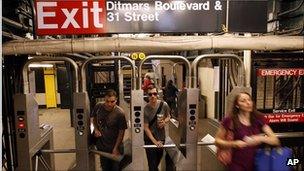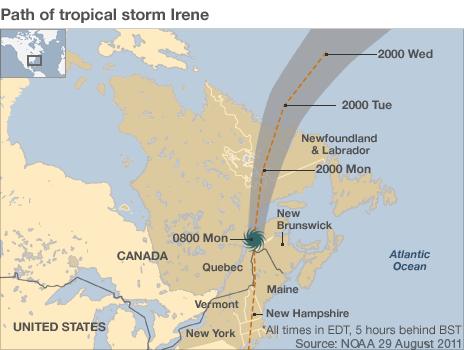Irene: Vermont in flood as US counts storm cost
- Published
As aerial footage shows the damage caused by tropical storm Irene, the BBC's Steve Kingstone described the challenges faced by the Obama administration
The US has begun clearing up after the impact of Tropical Storm Irene, which has killed as many as 28 people.
The storm is now soaking Canada's north-east, while the north-eastern US is battling historic floods; five million US homes have lost power.
In New York, which escaped a major disaster, transport resumed on Monday.
The small state of Vermont was reeling from the worst flooding in nearly a century, which washed away bridges and swamped the town of Brattleboro.
"We prepared for the worst and we got the worst in central and southern Vermont," Governor Peter Shumlin said on Monday.
"We have extraordinary infrastructure damage."
Vermont lashed
Hundreds of people have been told to leave the state capital, Montpelier, which could face two inundations: firstly from Irene, and again if the local water company decides to release water to save the Marshal Reservoir, a local dam where waters are reaching record levels.
Scott Snyder from the American Red Cross: "Some rivers are still rising"
A woman was swept away by an overflowing river in the Vermont town of Wilmington.
Authorities asked people to avoid travelling in the state, and warned of significant flooding, damaged roads and downed power lines.
State office buildings, schools and universities were shut on Monday.
"It's very serious for us at the moment in Vermont. The top two-thirds of the state are inundated with rapidly rising waters, which we anticipate will be an issue for the next 24 hours," said Robert Stirewalt, a spokesman for Vermont Emergency Management Agency.
Authorities said the hurricane was the worst natural disaster since a terrible flood in 1927.
President Barack Obama has warned that the impact of the storm will be felt for some time and that the recovery effort along the east coast will last for weeks.
Flooding and power cuts are still a risk as swollen rivers could burst their banks, he said on Sunday.
The brunt of Irene's impact was felt by towns and suburbs from New Jersey to Vermont. Driving rains and flood tides damaged homes and cut power to more than three million people in New Jersey, Connecticut and New York alone.
On Monday, Governor of Connecticut Daniel Malloy said that in his state more homes were currently without power as a result of the storm than at any other time in the state's history.
In many areas electricity will not be restored for the rest of the week, Mr Malloy said.
As the east coast states began the long clean-up, at least 28 people were reported to be been killed at the weekend during the storm, by falling trees, ocean waves, downed power lines and raging floods.
President Obama: "The impact of the storm will last for some time"
Insurance pay-outs for storm-related damage could top $7bn (£4.3bn), the Consumer Federation of America estimated.
Claims for wind damage are expected to be one sixth those from Hurricane Katrina in 2005, and claims for flood damage, one tenth, the group estimated.
As it moved north-east, Irene was earlier downgraded to a tropical storm and then a post-tropical cyclone.
In its last major update, at 03:00 GMT (23:00 EDT on Sunday night), Irene was moving north-north-east at a speed of 26mph (43km/h), the National Hurricane Center in Miami said.
An increase in speed is expected over the next couple of days, with the centre of the storm moving over eastern Canada on Monday. A tropical storm warning for Canada was likely to be lifted on Monday, it added.
Back to work
The storm, downgraded from a hurricane, passed New York on Sunday.
More than 300,000 people evacuated from low-lying areas in New York City are now able to return home.
New Yorkers were attempting to return to work on Monday, with the city's subway network resuming at 06:00 (10:00 GMT) and its three main airports all due to reopen by the middle of the day.
More than half the commuter rail lines running into the city were suspended or delayed amid lingering flooding and mudslides.
The New York Stock Exchange opened for business on Monday and officials at the 9/11 memorial at the World Trade Center site said they had not lost a single tree.
The US air transport network began slowly clearing a backlog after cancellations at the weekend. More than 1,400 flights were cancelled on Monday, according to Flightaware.com, external, down from 7,804 on Sunday.
Airports in New York were the most wracked by cancellations, but Philadelphia and Boston airports were also affected.
In Philadelphia, officials lifted the city's first state of emergency since 1986. Several buildings were destroyed by the storm, but there were no deaths or injuries.

Subway service in New York resumed on Monday morning
Further south in North Carolina, Governor Beverly Perdue said some areas of the state were still unreachable. TV footage showed fallen trees and power lines.
Officials in Virginia have begun the clear-up, but say the damage was not as bad as feared.
The north-eastern seaboard is the most densely populated corridor in the US. More than 65 million people live in major cities from Washington DC in the south to Baltimore, Philadelphia, New York and Boston further north.
Irene was classified as a category three hurricane, with winds of more than 120mph (192km/h), when it swept through the Caribbean last week.
